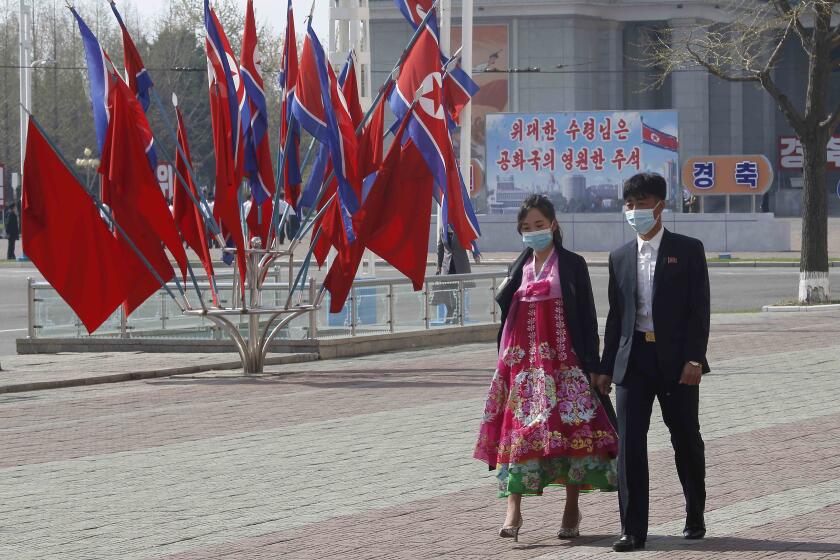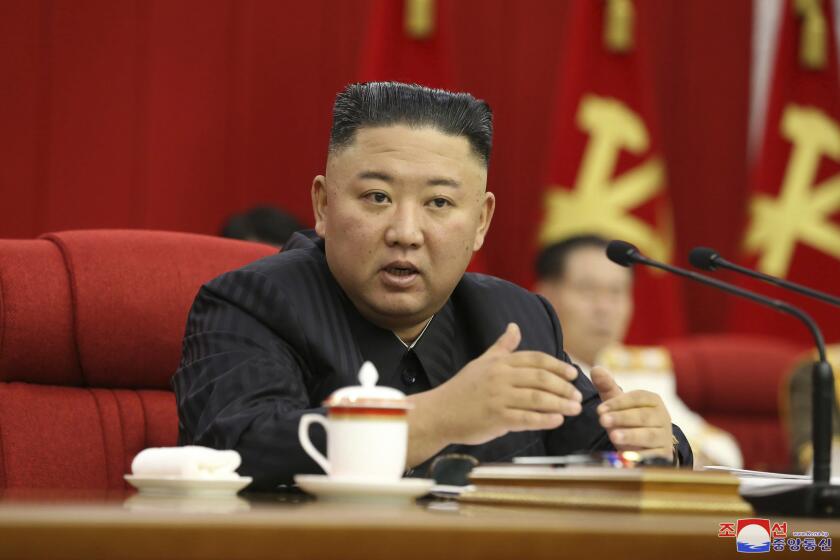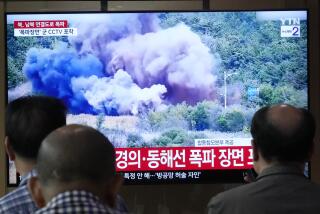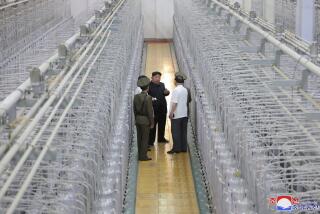In new challenge to U.S., North Korea says it tested long-range cruise missiles
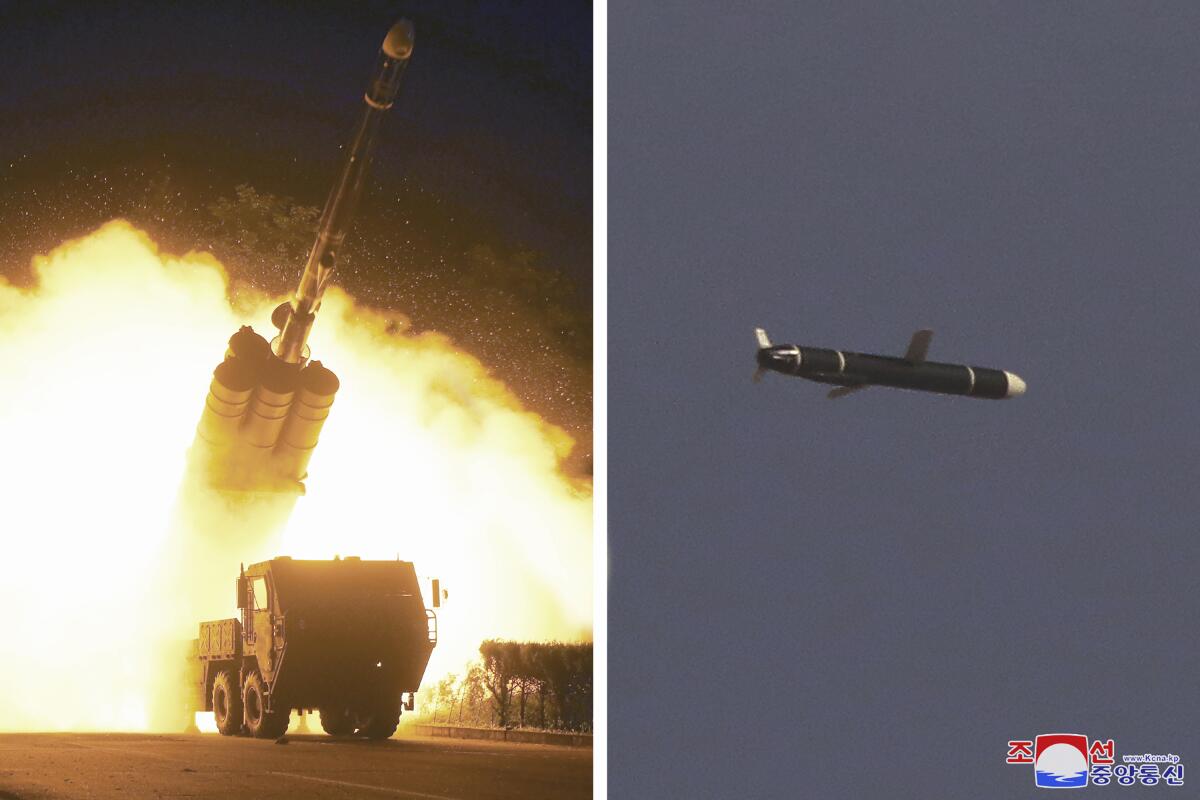
SEOUL — North Korea says it successfully test-fired what it described as newly developed long-range cruise missiles over the weekend, its first known testing activity in months that underscored how it continues to expand its military capabilities amid a stalemate in nuclear negotiations with the United States.
The state-run Korean Central News Agency (KCNA) said Monday that the cruise missiles, which had been under development for two years, demonstrated an ability to hit targets 932 miles away during its flight tests on Saturday and Sunday. State media published photos of a projectile being fired from a launcher truck and what looked like a missile traveling in the air.
North Korea hailed its new missiles as a “strategic weapon of great significance” that meets leader Kim Jong Un’s call to strengthen the country’s military might, implying that they were being developed with an intent to arm them with nuclear warheads.
North Korea says it needs nuclear weapons in order to deter what it claims is hostility from the U.S. and South Korea — and has long attempted to use the threat of such an arsenal to extract much-needed economic aid or otherwise apply pressure. The North and ally China faced off against South Korea and U.S.-led United Nations forces in the 1950-53 Korean War, a conflict that ended in an armistice that has yet to be replaced with a peace treaty.
The international community is bent on getting the North to abandon its nuclear arsenal and has long used a combination of the threat of sanctions and the promise of economic help to try to influence Pyongyang. But U.S.-led negotiations on the nuclear issue have been stalled since the collapse of a summit between then-President Trump and North Korean leader Kim Jong Un in 2019. At that time, the Americans rejected Kim’s demand for major sanctions relief in exchange for dismantling an aging nuclear complex.
North Korea ended a yearlong pause in ballistic tests in March by firing two short-range missiles into the sea, continuing a tradition of testing new U.S. administrations to measure Washington’s response. Kim’s government has so far rejected the Biden administration’s overtures for dialogue, demanding that Washington abandon its “hostile” policies first — a reference to the U.S. maintaining sanctions and a military alliance with South Korea.
U.N. human rights investigators have asked North Korea to clarify whether it has ordered troops to shoot on sight any trespassers who cross its northern border in violation of the country’s pandemic closure.
The U.S. keeps about 28,000 troops in South Korea to help deter potential aggression from North Korea, a legacy of the Korean War.
There hadn’t been any known North Korean test launches since March, as Kim focused his efforts on fending off the coronavirus and salvaging an economy damaged by sanctions, bad flooding in recent summers and border closures amid the COVID-19 pandemic. Experts have warned that the economic situation is dire, although monitoring groups have yet to detect signs of mass starvation or major instability.
The report of the tests comes before President Biden’s special representative for North Korea, Sung Kim, was to meet his South Korean and Japanese counterparts in Tokyo on Tuesday to discuss the stalled nuclear diplomacy with North Korea.
South Korea’s Joint Chiefs of Staff said the military was analyzing the North Korean launches based on U.S. and South Korean intelligence. South Korean Foreign Minister Chung Eui-yong said after a meeting with Australian Foreign Minister Marise Payne that the resumption of testing activity highlighted the urgent need for reviving diplomacy with the North.
After insisting for months that it has had no coronavirus infections, North Korea has come its closest to admitting that that might not be the case.
The U.S. Indo-Pacific Command said it was monitoring the situation with allies and that the North Korean activity reflects a continuing focus on “developing its military program and the threats that poses to its neighbors and the international community.” Japan said it was “extremely concerned.”
While the cruise missiles were clearly aimed at sending a message to Washington, the tests may indicate that North Korea is struggling with more provocative weapons systems, and might not garner much of a response, said Du-Hyeogn Cha, an analyst at Seoul’s Asan Institute for Policy Studies.
China, the North’s staunchest ally, had no direct comment on the missiles. Foreign Ministry spokesman Zhao Lijian urged “all parties concerned to exercise restraint, move in the same direction, actively engage in dialogue and contact” to reach a political settlement.
Kim during a congress of the ruling Workers’ Party in January doubled down on his pledge to bolster his nuclear deterrent in the face of U.S. sanctions and pressure and issued a long wish list of new sophisticated assets, including longer-range intercontinental ballistic missiles, nuclear-powered submarines, spy satellites and tactical nuclear weapons. Kim also said then that his national defense scientists were developing “intermediate-range cruise missiles with the most powerful warheads in the world.”
Kim Jong Un has ordered his government to be fully prepared for confrontation with the United States over North Korea’s nuclear arsenal.
KCNA said the missiles tested over the weekend traveled for 126 minutes above North Korean territory before hitting their targets. “In all, the efficiency and practicality of the weapon system operation was confirmed to be excellent,” it said.
It appeared that Kim wasn’t in attendance to observe the tests. KCNA said Kim’s top military official, Pak Jong Chon, observed the test-firings and called for the country’s defense scientists to go “all out to increase” the North’s military capabilities.
Japanese Chief Cabinet Secretary Katsunobu Kato said North Korean missiles of such range would pose a “serious threat to the peace and safety of Japan and its surrounding areas.”
“We are extremely concerned,” Kato said while mentioning Japanese efforts to strengthen its missile defense capabilities. He said Tokyo was working with Washington and Seoul to gather information on North Korea’s latest tests but said there was no immediate indication that the weapons reached inside Japan’s exclusive economic zone.
Breaking News
Get breaking news, investigations, analysis and more signature journalism from the Los Angeles Times in your inbox.
You may occasionally receive promotional content from the Los Angeles Times.
Kim’s powerful sister last month hinted that North Korea was ready to resume weapons testing while issuing a statement berating the United States and South Korea for continuing their joint military exercises, which she said was the “most vivid expression of U.S. hostile policy.”
The allies say the drills are defensive in nature, but they have canceled or downsized them in recent years to create space for diplomacy or in response to COVID-19.
Talks between the United States and North Korea have stalled since the collapse of a summit between Trump and Kim in 2019, when the Americans rejected the North’s demand for major sanctions relief in exchange for a partial surrender of its nuclear capabilities. Kim’s government has so far rejected the Biden administration’s overtures for dialogue, demanding that Washington abandon its “hostile” policies first.
The latest tests came after Kim threw an unusual parade in the capital, Pyongyang, last week that was a marked departure from past militaristic displays, showcasing anti-virus workers in hazmat suits and civil defense organizations involved in industrial work and rebuilding communities destroyed by floods instead of missiles and other provocative weaponry.
Experts said that the parade was focused on domestic unity as Kim now faces perhaps his toughest test, with the economy in tatters.
More to Read
Sign up for Essential California
The most important California stories and recommendations in your inbox every morning.
You may occasionally receive promotional content from the Los Angeles Times.

